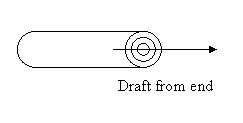I started spinning on my new Matchless this past weekend. No more clunking and rattling that I experienced with my old Matchless. Ah…peace and quiet. Except…wait! Why isn’t it drawing in? No matter how I adjust the scotch tension, it sometimes just refused to draw in. It felt as if some fiber was caught somewhere, and the twist doesn’t travel all the way to my drafting triangle. But it doesn’t happen all the time.
More research … I notice that this only happens when I use the hooks on the left side of the flyer, but doesn’t happen when I use the hooks on the right. I don’t see anything specifically, so … I think there is a burr in the orifice that only occurs when the yarn is drawing in from the left side of the orifice. My fingers are too fat to find the burr.

Then I remembered a tip that Judith showed me — lacing the yarn from side to side. This now has the yarn traveling through the orifice at the correct angle.
Lacing is useful when you are spinning a really fine yarn, and you want to reduce the take up. Why would you want to reduce the lace up? Reducing the take up allows you more time to put the twist that you need for a really fine yarn before the yarn winds on.
Lacing only works for spinning wheels whose hooks are on the same face of the flyer, such as the Majacrafts. This doesn’t work on the Ashford wheels, unless you add some more cup hooks on the flyer.
For now? I don’t need the extra time for the reason stated above. I need the extra time until weekend, when I can dig in the garage for my set of fine metal files and fix that darn burr.


 I started to attenuate the rolag so I can spin off one end. But I wasn’t getting as much control over the fiber as I wished, and I was afraid that I was going to muddy the progression of colors. That I definitely didn’t want.
I started to attenuate the rolag so I can spin off one end. But I wasn’t getting as much control over the fiber as I wished, and I was afraid that I was going to muddy the progression of colors. That I definitely didn’t want.